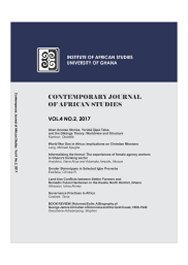Akan Ananse Stories, Yorùbá Ìjàpá Tales, and the Dikenga Theory: Worldview and Structure
Abstract
In this paper, we aim to use Dikenga, the cosmogram of the Bakôngo, as an Afrikan cosmological, philosophical, conceptual, and theoretical framework to analyze the structure of Akan Ananse and Yorùbá Ìjàpá stories. According to Fu-Kiau, “nothing exists that does not follow the steps of the cyclical Kongo cosmogram” (Fu-Kiau 1994: 26). This bold hypothesis is tested in this study by applying what we term the “Dikènga theory of literary analysis” to the aforementioned stories. We find that this theoretical framework can help us shift away from concepts of “storylines” and “timelines” to reveal the patterned and cyclical nature of material, spatial and temporal phenomena. Further, we find such an approach may deepen our understanding of these stories as manifestations of a shared Afrikan worldview.
Dans cet article, nous visons à utiliser Dikenga, le cosmogramme du Bakôngo, comme un cadre cosmologique, philosophique, théorique et conceptuel Afrikan pour analyser la structure des histoires d’Akan Ananse et Yorùbá Ìjàpá. Selon Fu-Kiau, “il n’existe rien qui ne suit pas les étapes du cosmogramme Kongo cyclique” (Fu-Kiau 1994: 26). Cette hypothèse audacieuse est testée dans cette étude en appliquant ce que nous appelons la «théorie Dikènga de l’analyse littéraire» aux histoires susmentionnées. Nous trouvons que ce cadre théorique peut nous aider à nous éloigner des concepts de «scénarios» et de «délais» pour révéler la nature structurale et cyclique des phénomènes matériels, spatiaux et temporels. De plus, nous trouvons une telle approche peut approfondir notre compréhension de ces histoires comme des manifestations d’une vision du monde Afrikan partagée.


Leave a Reply